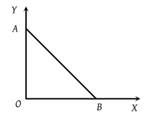As per this diagram a point charge +q is placed at the origin O. Work done in taking another point charge –Q from the point A [co-ordinates (0, a)] to another point B [co-ordinates (a, 0)] along the straight path AB is

1. Zero
2.
3.
4.

The capacity of a condenser is 4 × 10–6 farad and its potential is 100 volts. The energy released on discharging it fully will be -
1. 0.02 Joule
2. 0.04 Joule
3. 0.025 Joule
4. 0.05 Joule
The energy stored in a condenser of capacity C which has been raised to a potential V is given by -
1.
2.
3. CV
4.
Eight drops of mercury of equal radii possessing equal charges combine to form a big drop. Then the capacitance of bigger drop compared to each individual small drop is
1. 8 times
2. 4 times
3. 2 times
4. 32 times
The capacity of a parallel plate condenser is C. It's capacity when the separation between the plates is halved will be?
1. 4 C
2. 2 C
3.
4.
If the dielectric constant and dielectric strength be denoted by \(k\) and \(x\) respectively, then a material suitable for use as a dielectric in a capacitor must have:
1. high \(k\) and high \(x\).
2. high \(k\) and low \(x\).
3. low \(k\) and low \(x\).
4. low \(k\) and high \(x\).
64 drops each having the capacity C and potential V are combined to form a big drop. If the charge on the small drop is q, then the charge on the big drop will be
1. 2q
2. 4q
3. 16q
4. 64q
The capacity of a parallel plate capacitor increases with the
1. Decrease of its area
2. Increase of its distance
3. Increase of its area
4. None of the above
The true statement is, on increasing the distance between the plates of a parallel plate condenser -
1. The electric intensity between the plates will decrease
2. The electric intensity between the plates will increase
3. The electric intensity between the plates will remain unchanged
4. The P.D. between the plates will decrease
Force of attraction between the plates of a parallel plate capacitor whose dielectric constant is K will be -
1.
2.
3.
4.






